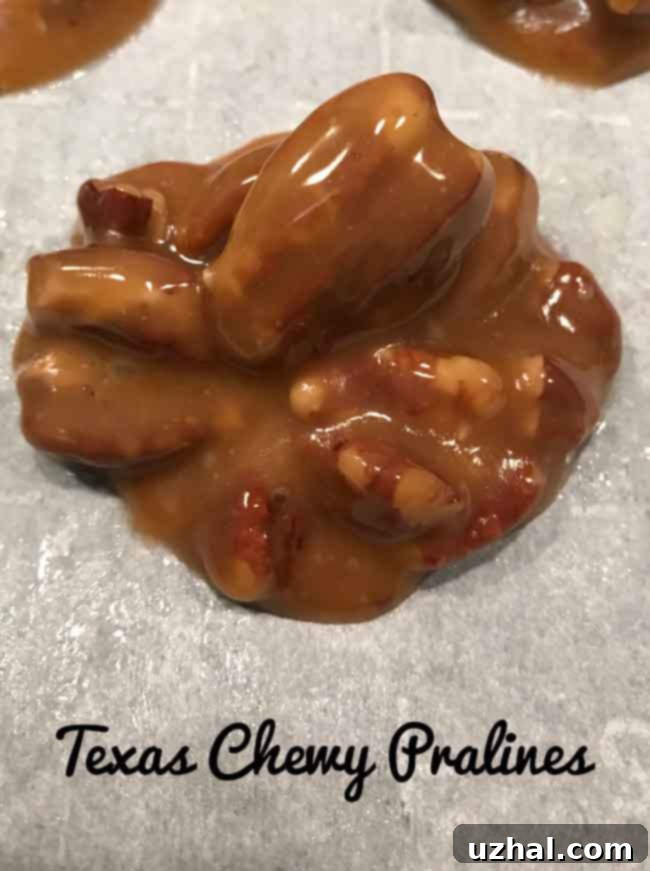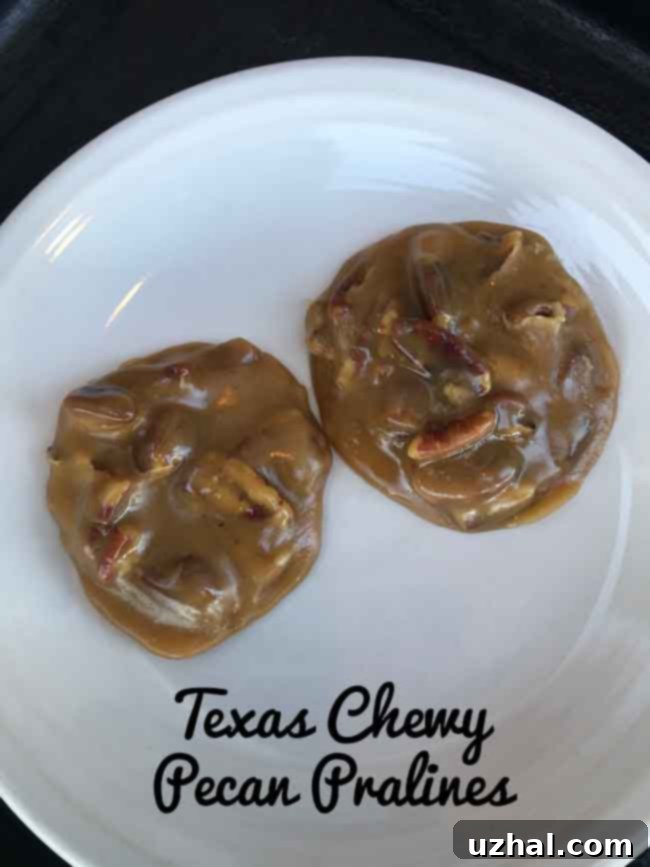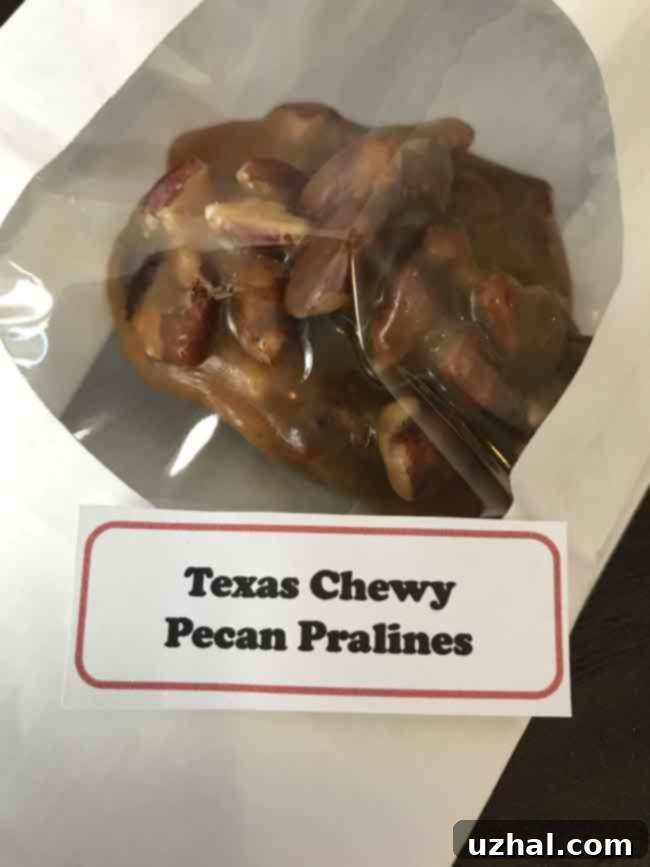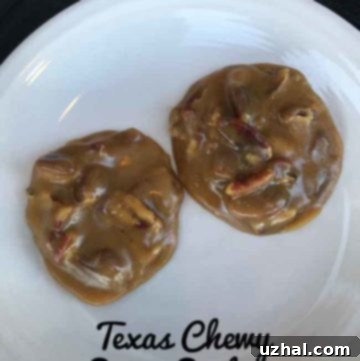Authentic Texas Chewy Pralines: A Lammes-Inspired Homemade Recipe
There’s a special kind of magic found in a truly well-made praline, especially in Texas. For generations, the name Lammes has been synonymous with this sweet, nutty confection in the Lone Star State. Their chewy pralines, in particular, hold a cherished place in the hearts of Texans, including my great-grandmother, whose fondness for Lammes Candies always brings a smile to my face. It was her memory that inspired me yesterday as I embarked on a delightful culinary journey to recreate these iconic Texas Chewy Pralines right in my own kitchen. More than just a simple candy, these pralines represent a piece of Texan heritage, a perfect blend of rich flavors and an irresistible, melt-in-your-mouth chewiness that sets them apart.

The Secret to Perfectly Chewy Texas Pralines: Rich, Not Overly Sweet
One of the most remarkable qualities of Lammes’ pralines, and indeed these homemade Texas Chewy Pralines, is their exquisite balance. They are wonderfully soft, incredibly chewy, and burst with a deep, satisfying flavor without being overwhelmingly sugary. This delicate balance is achieved through a generous incorporation of high-quality ingredients: ample amounts of real butter, luscious heavy cream, and, of course, an abundance of fresh pecans. These components work in harmony to impart a profound richness that permeates every bite, allowing the natural sweetness to shine through without becoming cloying. Unlike some other candy variations that rely heavily on sugar for their appeal, these pralines offer a sophisticated sweetness, making them a truly indulgent, yet perfectly balanced, treat. It’s this characteristic richness that elevates them from a mere sweet to a truly memorable dessert experience.

My culinary adventure began with a clone recipe, a fantastic starting point designed to mimic the renowned Lammes taste and texture. However, as with any good recipe, I believe there’s always room for a personal touch and thoughtful improvements. The initial recipe suggested using light corn syrup, but a valuable tip from seasoned praline enthusiasts familiar with the distinct Lammes flavor hinted at the use of dark corn syrup. Embracing this advice, I opted for a combination of both dark and light corn syrups, which I found contributed to a deeper, more nuanced caramel note and an even richer color. This seemingly small change made a significant difference in achieving that authentic depth of flavor.
Another modification involved elevating the pecans, which are undeniably the star of any praline. Instead of simply adding raw pecans, I chose to toast them gently. This step intensifies their nutty flavor and gives them a delightful crunch that contrasts beautifully with the praline’s chewiness. After toasting, I tossed them in a touch of extra butter and a pinch of salt. This simple addition not only enhanced their natural taste but also added a subtle savory counterpoint that further balanced the sweetness of the candy. Lastly, the original recipe called for a truly monumental batch – two pounds of pecans and a full pound of butter! While admirable, this quantity is often too large for most home cooks. To make this delicious treat more accessible, I scaled the recipe down considerably, yielding a manageable 18 pralines, perfect for sharing with family or savoring over a few days without feeling overwhelmed.

Choosing the Right Saucepan: A Critical Step in Candy Making
When embarking on candy making, especially with delicate confections like pralines, the right equipment can make all the difference. One aspect that often gets overlooked is the size of your saucepan. While scaling my recipe down from a massive 56 pralines to a more manageable 18, I found myself pondering the ideal vessel. My trusty 3-quart nonstick pan felt a bit large for the reduced amount of candy mixture, but a 2-quart pan seemed too small, risking boil-overs and uneven cooking. Ultimately, I decided to proceed with the 3-quart pan, and my choice proved to be a good one. The candy mixture reached a sufficient depth, allowing my candy thermometer to be properly submerged without touching the bottom, which is crucial for accurate temperature readings. This proper immersion ensured that I could precisely monitor and control the heat, allowing the temperature to rise at a slow, steady, and predictable pace. Maintaining this gentle temperature increase is key to developing the perfect texture and preventing crystallization, leading to a much more consistent and successful batch of chewy pralines. A pan that’s too wide or too shallow can cause the mixture to heat too quickly or unevenly, making it harder to control the delicate process required for perfect candy.
Once the heat was rising slowly and steadily, the entire recipe came together with surprising ease, transforming what can sometimes be a stressful cooking process into a truly relaxing experience. A significant advantage of making chewy pralines, as opposed to their crispier counterparts, is that you don’t have to engage in a frantic race against time. With chewy pralines, the fear of the sugar crystallizing in the pan before you can drop them is greatly reduced. Their nature allows for a more forgiving setting time, giving you ample opportunity to scoop them onto parchment paper without rushing. This extended working time not only makes the process more enjoyable but also helps ensure each praline is perfectly formed and maintains its signature soft, pliable texture. Patience and observation are your best tools here, allowing the mixture to slightly cool and thicken before dropping for ideal results.
The Perfect Pecan Ratio: Adjusting to Your Taste
Pecans are undeniably the star of Texas Chewy Pralines, and their abundance is a hallmark of this regional delicacy. I typically start with two cups of pecan pieces, which I meticulously toast and then toss with a little butter and salt to enhance their flavor and texture. This generous amount ensures that every bite is packed with nutty goodness. However, taste is a deeply personal matter, and I received valuable feedback from a reader named Sally, who thoughtfully mentioned in the comments that she felt two cups might be too many pecans for her preference. This highlights an important aspect of cooking: flexibility. While I love a very pecan-dense praline, you absolutely have the freedom to adjust the amount to suit your own liking. If you prefer a higher ratio of the creamy candy base to nuts, feel free to hold back some of the toasted pecans. You could start with 1.5 cups and add more if you feel it needs it, or simply use 2 cups and see how you like it. The beauty of homemade candy is that you are the master of your kitchen, and tailoring the recipe to your personal taste is part of the joy. Just ensure the pecans are high-quality; fresh, flavorful pecans are essential for the best praline experience.
A Brief History of Pralines: From France to the Heart of Texas
To truly appreciate the Texas Chewy Praline, it’s worth understanding its fascinating journey. The praline originated in France in the 17th century, reputedly created by the chef of César, duc de Choiseul, comte du Plessis-Praslin (hence the name). These early French pralines were typically whole almonds coated in caramelized sugar, often ground into a powder or paste to flavor pastries and chocolates. When French Ursuline nuns arrived in New Orleans in the early 18th century, they brought the praline recipe with them. Here, the local availability of abundant pecans led to a significant adaptation, transforming the almond-based confection into the pecan praline we know today. Over time, the recipe evolved, taking on a distinctly Southern character, often incorporating cream or butter to create a softer, richer candy. As settlers moved westward, the praline found its way to Texas, where it was embraced and further refined. The Texas Chewy Praline developed its unique identity, emphasizing a rich, buttery, and incredibly soft chewiness that distinguishes it from the often-firmer or more granular New Orleans style. It’s a testament to regional culinary evolution, making this sweet treat not just a candy, but a piece of culinary history.
Essential Tips for Praline Perfection
Making pralines, while rewarding, can sometimes be a bit tricky. Here are a few extra tips to ensure your Texas Chewy Pralines turn out perfectly every time:
- **Accurate Thermometer:** A reliable candy thermometer is your best friend. Calibrate it regularly by checking it in boiling water (should read 212°F or 100°C at sea level). Inaccurate readings are a common cause of failed candy batches.
- **Patience is Key:** Don’t rush the heating process. Slow and steady temperature increases allow the sugar to dissolve properly and prevent scorching.
- **Humidity Matters:** Candy making is sensitive to humidity. On very humid days, sugar can absorb moisture from the air, making it harder for the candy to set properly. If possible, choose a dry day for your praline-making adventure.
- **Stirring Techniques:** While the initial sugar and corn syrup mixture might not need much stirring, once the cream and butter are added, constant, gentle stirring is important to prevent burning and ensure even cooking.
- **Cooling Before Dropping:** With chewy pralines, a slight cooling and thickening of the mixture off the heat is beneficial before dropping. This allows the pralines to hold their shape better and achieve that ideal chewy texture. If your first drop spreads too much, stir the mixture for another minute or two to allow it to cool further.
- **Proper Storage:** Once set, store your pralines in an airtight container at room temperature. They can last for up to a week, though they rarely do in my house!
Serving and Gifting Your Homemade Texas Chewy Pralines
Once your Texas Chewy Pralines have cooled and set, they are ready to be enjoyed! These delightful treats are perfect on their own, offering a rich burst of flavor and a satisfying chewiness. However, they can also be incorporated into other culinary delights. Imagine a crumbled praline topping on vanilla ice cream or a warm slice of apple pie – simply divine! They also pair wonderfully with a robust cup of coffee or a glass of cold milk, providing a comforting contrast to the sweet, nutty flavors. If you’re looking for a thoughtful homemade gift, these pralines are an excellent choice. Arrange them in a decorative box or clear cellophane bags tied with a ribbon. They are always appreciated, especially by anyone who appreciates a taste of authentic Texas hospitality and a touch of nostalgic sweetness. Their robust flavor and tender texture make them an ideal treat for holidays, special occasions, or simply as a token of appreciation for friends and family.
- Oatmeal Praline Cookies
- Southern Style Pecan Pralines
- Praline Drizzle Chocolate Bundt Cake
- Paula’s Pecan Pralines
- Praline Brookies!
Recipe: Small Batch Texas Chewy Pralines

Texas Chewy Pralines Small Batch
Pin Recipe
Ingredients
- 2 cups pecan pieces plus about a teaspoon butter and pinch of salt
- ¼ cup white sugar 50 grams
- ¼ cup dark brown sugar 50 grams
- ½ cup corn syrup use half light and half dark (Karo)
- 1 stick 114 grams salted butter (Land o’ Lakes)
- ½ cup heavy cream
- ½ teaspoon vanilla
- Tiny pinch of salt
Instructions
-
Line a baking sheet or flat surface with parchment paper.
-
Lay the pecans on a rimmed baking sheet and bake at 375 for 7 minutes or until they start to release their oils. Pull from oven and toss with about a teaspoon of butter and a sprinkling of salt. Set aside to cool completely. You can use all of the pecans, or if you like fewer pecans, hold some back.
-
In a heavy 3 quart saucepan (preferably nonstick), combine both sugars and corn syrup. Put the pan over medium, insert the candy thermometer and heat until mixture reaches 250 degrees F. This should take about 10-15 minutes, and you shouldn’t really need to stir much. Keep the heat rising slowly and steady.
-
Remove from heat and stir in butter, one chunk at a time until melted. Pour in the cream, then return the pan to heat, stirring constantly and keeping the candy at a slow boil/rapid simmer, until mixture reaches 242 degrees F. This should take about 15 minutes. It’s important to go slow and keep the mixture moving just enough not to burn. If temperature stalls, raise it in tiny increments.
-
Remove from heat and add pecans, vanilla and salt, then stir with a wooden spoon allowing the mixture to cool and thicken just slightly. Drop by spoonfuls onto the parchment lined paper and let set. Note: You don’t have to work as quickly with chewy pralines because it takes longer for them to set. In fact, if the first one you spoon out runs just stir a bit and let the mixture cool and thicken a little before spooning out the next one.
